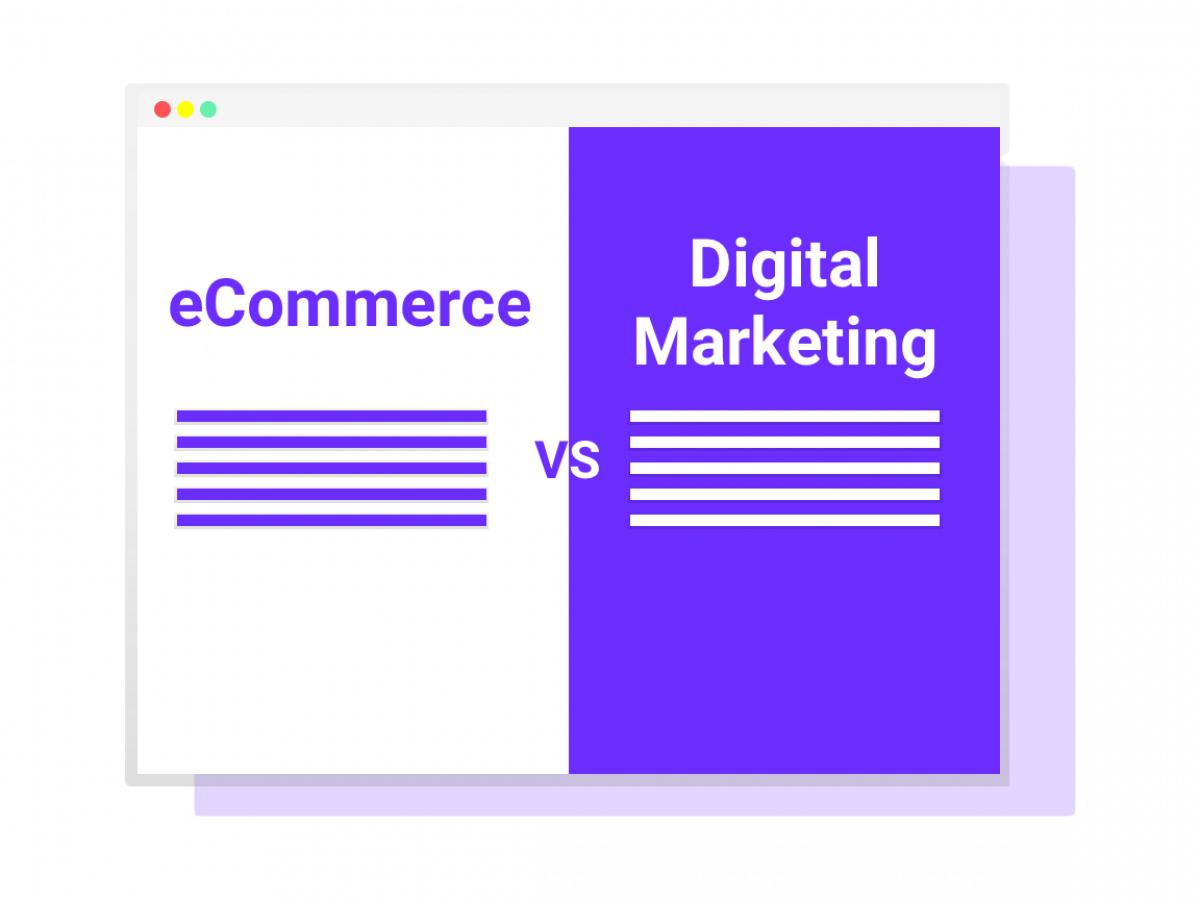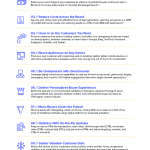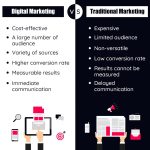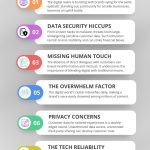What is the Difference between Digital Marketing And E-Commerce
Digital Marketing encompasses the entire online promotional strategies to reach consumers, while E-Commerce specifically refers to buying and selling goods or services over the internet. Digital Marketing is an umbrella term that covers SEO, content marketing, social media, and more to attract, engage, and convert customers online. Digital marketing and…
Digital Marketing encompasses the entire online promotional strategies to reach consumers, while E-Commerce specifically refers to buying and selling goods or services over the internet. Digital Marketing is an umbrella term that covers SEO, content marketing, social media, and more to attract, engage, and convert customers online.
Digital marketing and e-commerce often intersect but serve distinct functions within the online business landscape. Companies leverage digital marketing strategies to promote their brand, products, and services, aiming to drive traffic to their website or e-commerce platform. Effective digital marketing can lead to higher visibility, increased brand recognition, and customer loyalty.
E-commerce, on the other hand, is focused on the transactional process, providing a platform for customers to make purchases. It relies on robust digital marketing to fuel its sales engine, but its core is the online shopping experience, checkout process, and payment systems. Understanding the nuances between the two is essential for businesses seeking to establish a strong online presence and drive sales in the digital age.

Credit: www.pinterest.com
Digital Marketing Unveiled
Imagine a world where your brand shines brightest. Digital marketing makes this possible. Unlike e-commerce, which is all about selling online, digital marketing promotes your business across the vast digital landscape. Let’s dive into this digital universe and discover how it fuels business growth.
The Essence Of Digital Marketing
At its core, digital marketing connects you with customers online. Picture a toolbox filled with creative strategies and digital tools. These tools help your brand speak directly to your audience. They lay the path for potential customers to find and engage with your online storefront or content, turning clicks into loyal customers.
- Search Engine Optimization (SEO): Leads your audience to you.
- Social Media Marketing: Builds community and conversation.
- Email Marketing: Keeps your brand top-of-mind.
- Content Marketing: Provides value to your audience.
- Pay-Per-Click (PPC): Drives targeted traffic quickly.
Core Strategies Of Digital Marketing
Digital marketing grows your online presence through various strategies. Let’s explore them:
| Strategy | Description | Benefits |
|---|---|---|
| SEO | Makes your site visible on search engines. | Attracts organic traffic, increases credibility. |
| Content Marketing | Shares valuable information. | Engages readers, builds trust. |
| Social Media Marketing | Connects with customers on social platforms. | Boosts brand awareness, fosters community. |
| Email Marketing | Sends targeted messages to subscribers. | Personalizes experience, improves retention. |
| PPC Advertising | Displays ads to prompt user action. | Generates immediate results, scalable. |
E-commerce Explored
An understanding of e-commerce is crucial in the digital age. It’s the backbone of online shopping. Here we’ll dive into what makes e-commerce unique. We’ll cover its definition and key components.
Defining E-commerce
E-commerce involves buying and selling online. It is where you find products on the internet. It’s a virtual version of a mall or store. In e-commerce, the internet is your shopping space. E-commerce stores are open all day, every day.
Main Components Of E-commerce
E-commerce has several important parts. All parts must work together. This ensures a smooth experience for everyone. Below is a list of the main components:
- Online Storefront: The website or app where you shop.
- Shopping Cart Software: It lets you add products to buy.
- Payment Gateway: It allows safe payment transfers.
- Customer Service: Help and support for shoppers.
- Marketing: It attracts and keeps customers.
- Shipping and Delivery: It gets the product to your door.
A successful e-commerce site needs good technology. It should be easy to use. Good security is a must too. These are vital for shopper trust. Happy customers come back.
Historical Evolution
The journey of digital marketing and e-commerce has reshaped the way businesses interact with customers. The transformation within these realms reveals a rich history characterized by innovation and growth.
Digital Marketing Through The Years
Digital marketing’s evolution started when the internet became accessible to the masses. This access shifted how brands reach audiences. From banner ads in the 1990s to search engines refining user experience, key timelines shed light on these changes.
- 1990s: The first banner ad went live, introducing the world to digital advertising.
- 2000s: Google AdWords launched, revolutionizing keyword targeting.
- 2010s: Social media platforms became major players in online advertising.
- 2020s: AI and machine learning began shaping personalized marketing.
The Rise Of E-commerce
E-commerce took flight with the advent of the internet. Its history is marked by significant events that fueled its rise. Let’s delve into the milestones that compose the e-commerce timeline.
| Year | Milestone |
|---|---|
| 1995: | Amazon and eBay launched, setting the stage for online shopping. |
| 1998: | PayPal emerged, simplifying online transactions. |
| 2000s: | Secure payment systems improved, boosting consumer trust. |
| 2010s: | Mobile shopping surged with smartphones in every pocket. |
Functional Differences
Understanding the functional differences between digital marketing and e-commerce clarifies their unique roles in the digital world. Let’s explore these distinctions, focusing on their purposes, goals, and the tools and techniques they employ.
Purpose And Goals
Digital marketing aims to promote brands and build preference. It uses various channels to cultivate a brand’s presence. The goal is to reach potential customers and engage with them.
On the other hand, e-commerce focuses on facilitating transactions. It allows customers to buy and sell goods online. Its primary goal is to convert visitors into customers and complete the sale.
Tools And Techniques
| Digital Marketing Tools | E-Commerce Tools |
|---|---|
| SEO tools | Shopping carts |
| Social media platforms | Payment gateways |
| Email marketing software | Product recommendation engines |
| Content management systems | Inventory management systems |
| Analytics tools | Customer service tools |
Digital marketing utilizes tools like SEO to improve visibility. Social media establishes brand presence. Email marketing and content management systems nurture leads.
E-commerce leverages shopping carts for easy purchases. Payment gateways secure transactions. Product recommendation tools and inventory management enhance the shopping experience. Effective customer service tools retain buyers.
Technological Underpinnings
The technological underpinnings of digital marketing and e-commerce reveal vital differences. Each relies on distinct sets of tools that power their strategies and operations. Understanding their technological stacks clarifies how digital marketing and e-commerce complement and differ from each other.
Software And Platforms
In digital marketing, software choices focus on outreach and engagement. Marketers need platforms for content management, such as WordPress, and tools like Hootsuite for social media management. E-commerce businesses, however, prioritize software that enables online sales transactions. They require shopping carts, payment gateways such as PayPal, and inventory management systems.
- Content Management Systems (CMS): Used by digital marketers to publish and manage content.
- Social Media Tools: These platforms help in scheduling posts and analyzing engagement.
- E-Commerce Platforms: Online stores use platforms like Shopify to sell products.
- Payment Solutions: Secure payment platforms are a must-have for e-commerce sites.
Data And Analytics Usage
Data and analytics form the backbone of modern strategies for both fields. Digital marketing exploits data to target and retarget audiences precisely. Tools such as Google Analytics enable marketers to track campaign performance and user behavior. E-commerce sites also leverage analytics to understand customer journeys but put a greater emphasis on conversion rate optimization.
| Aspect | Digital Marketing | E-Commerce |
|---|---|---|
| Main Focus | User engagement | Conversions |
| Data Usage | Audience segmentation | Shopping behavior |
| Tools | SEO tracking | Customer relationship management |
Understanding the right technology helps businesses execute focused strategies. It ensures they meet their specific goals. With the right tools and insights, success is more achievable in the connected world of online commerce and marketing.

Credit: ippei.com
Impact On Business Growth
The growth trajectory of a business in today’s digital age hinges on how effectively it leverages online channels for marketing and sales. Understanding the contrasts between digital marketing and e-commerce can sharpen strategies for business expansion and success.
Digital Marketing’s Role In Scaling Businesses
Digital marketing serves as a catalyst for business scaling. It comprises varied strategies designed to reach audiences, engage customers, and build brand loyalty. This approach is multifaceted:
- SEO: Improves website visibility in search engine results.
- Social Media: Connects with customers where they spend time online.
- Email Campaigns: Nurtures leads and encourages repeat business.
- Content Marketing: Attracts new visitors through informative and engaging content.
Each aspect works in synergy to boost the online presence, drive traffic, and ultimately – scale operations.
Contribution Of E-commerce To Revenue
E-commerce platforms are online sales powerhouses transforming how businesses achieve revenue goals. Their impact is direct:
| Feature | Impact |
|---|---|
| 24/7 Availability | Sales around the clock, boosting profit potential. |
| Global Reach | Access to wider markets and diverse customer bases. |
| Lower Costs | Reductions in traditional retail overhead. |
| Data Analysis | Insights into customer behavior for tailored marketing. |
E-commerce introduces efficiency and scalability to the sales process, making it a crucial component in boosting business revenue.
Case Studies
Diving into case studies offers real-world insights into the impact of digital marketing and e-commerce strategies. These stories detail the journeys of brands and their quest for online success. Let’s explore some noteworthy examples that highlight the transformative power of each field.
Success Stories in Digital MarketingSuccess Stories In Digital Marketing
Digital marketing helps brands reach vast audiences. It focuses on creating online visibility across various digital channels. Successful campaigns often lead to increased brand awareness and sales. Here, we shed light on brands that mastered digital marketing strategies.
- Company A boosted its social media presence, multiplying its engagement rate by 300% in six months.
- Brand B launched a content marketing campaign, resulting in a 150% uptick in website traffic.
- Start-Up C used pay-per-click advertising, slashing customer acquisition costs by half while doubling conversions.
E-commerce Giants: Before And After
E-commerce transforms how companies sell. It involves setting up online stores to reach customers globally. This section casts a spotlight on e-commerce giants and their growth stories, from small startups to industry leaders. Notice the striking before-and-after effects of e-commerce implementation.
| Brand | Before E-Commerce | After E-Commerce |
|---|---|---|
| Merchant X | Limited brick-and-mortar sales | Sales increased tenfold online |
| Retailer Y | Local store with regional reach | Global presence with customers in over 50 countries |
| Brand Z | Struggling with inventory management | Streamlined operations and reduced overhead costs |

Credit: m.youtube.com
Trends And Future Outlook
The digital landscape is constantly evolving, with new trends emerging at a rapid pace. Understanding these shifts is key for businesses looking to stay ahead. In this section, we’ll delve into the latest trends in digital marketing and e-commerce, revealing insights into their future.
Emerging Trends In Digital Marketing
Digital marketing thrives on innovation. Here’s what’s on the rise:
- Artificial Intelligence (AI): AI is reshaping marketing. It personalizes user experiences and improves decision-making.
- Chatbots: Instant customer service becomes a norm with chatbots. They provide 24/7 assistance with a human-like touch.
- Video Content: It dominates social platforms. Short, engaging videos capture attention and drive engagement.
- Influencer Collaborations: Brands partner with influencers to reach targeted audiences in a more authentic way.
- Voice Search Optimization: As voice assistants grow in popularity, optimizing for voice search becomes crucial.
The Future Of E-commerce
E-commerce is not just growing; it’s changing. Future highlights include:
- Mobile Shopping: Shopping through mobile devices will continue to soar. Easy and fast transactions favor this trend.
- Augmented Reality (AR): AR transforms shopping experiences. Customers can try products before buying online.
- Personalization: Tailored shopping experiences are the focus. Data analytics drives this personal touch.
- Subscription Services: Consumers love convenience. Subscription models provide recurring revenue for businesses.
- Green Consumerism: Eco-friendly products and practices win. Sustainability influences buying decisions more than ever before.
Frequently Asked Questions Of What Is The Difference Between Digital Marketing And E-commerce
What Is Digital Marketing?
Digital marketing refers to advertising delivered through digital channels such as search engines, websites, social media, email, and mobile apps. It uses the internet and online-based technologies to promote products, services, or brands to connect with potential customers.
How Does E-commerce Work?
E-commerce operates through websites or apps allowing consumers to buy and sell products or services over the internet. It involves electronic transactions, online product catalogs, and payment gateways to facilitate the entire buying process completely online.
What Distinguishes E-commerce From Digital Marketing?
E-commerce is focused on conducting commercial transactions online, while digital marketing involves using various digital channels to promote a brand, product, or service. E-commerce is a subset of digital marketing, which encompasses a wider array of marketing activities.
Can Digital Marketing Drive E-commerce Sales?
Yes, digital marketing can significantly drive e-commerce sales by reaching potential customers through SEO, PPC, social media ads, content marketing, and email campaigns. These strategies enhance online visibility and attract customers to e-commerce platforms.
Conclusion
Understanding the distinctions between digital marketing and e-commerce is crucial for modern business strategies. Digital marketing fuels brand awareness and attracts customers, while e-commerce focuses on online sales. Each plays a pivotal role in the digital economy, and their effective integration can drive success in our increasingly digital marketplace.
Embrace both for optimal results.







